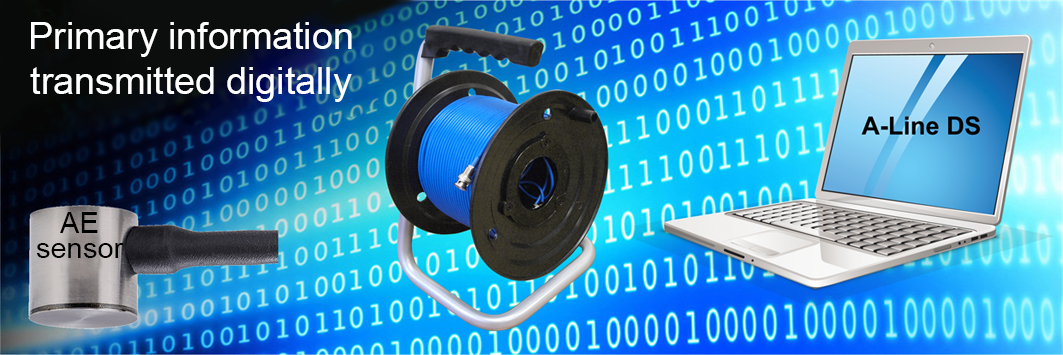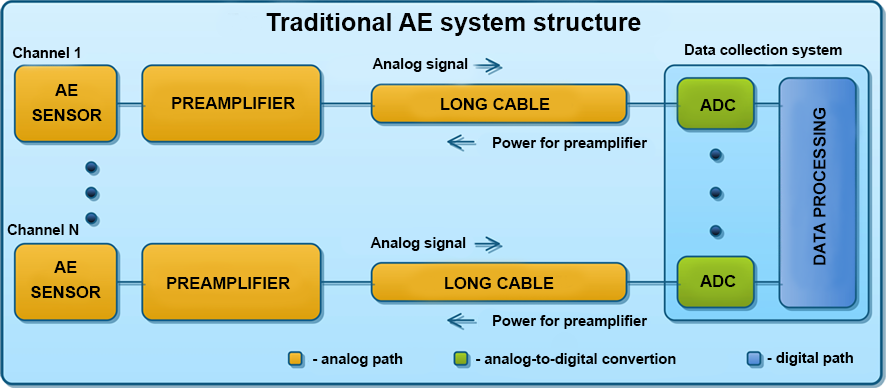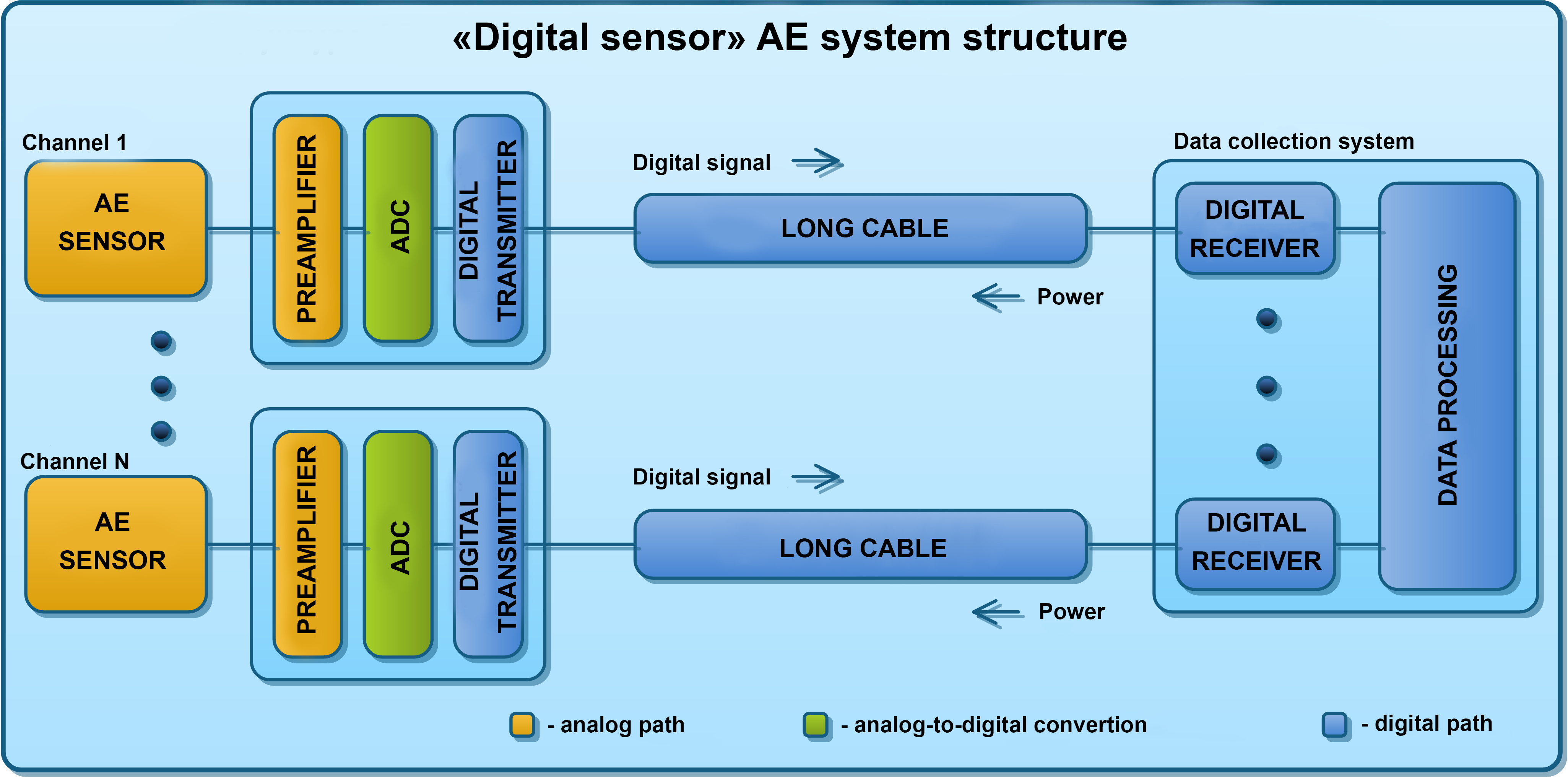-
SMART AE
The AE testing method has a number of remarkable features. It is a passive method of testing with a high sensitivity to crack detection, which does not require scanning of the object surface and provides remote test on sections from a few centimeters to hundreds of meters. However, this method has some disadvantages: sensitivity to acoustic noise caused by operation of the equipment tested, complexity of quantitative estimation of the defect parameters, severe requirements for qualification of the personnel conducting the AE testing, whish are caused by the challenging intelligent content of the method.
In the SMART technology the nonthreshold method is used in data recording, wherein the release of AE impulses is based on the change in properties of the flow of acoustic events. Using the digital processing of signals, the pulses of acoustic emission and noises are automatically separate. In this case leakages and process disturbances can be detected by the nature of noise. An important advantage of the new technology is the ability to recognize a continuous acoustic emission before the tested object is destructed. Of prime importance is the fact that the SMART technology is implemented in the hardware of AE complex, and this allows it to be used in the on-line mode when acquiring data.
The traditional threshold method of data recording is reliable and easy to implement, but has a variety of essential drawbacks. Firstly, the choice of threshold value is within the operator’s sphere, and due to the influence of human factor the threshold can be specified incorrectly. Secondly, at the data threshold recording, the time of signal arrival is determined by the time it crosses the threshold - this method does not allow to determine the exact time of arrival of the signal, and the error in determining the time of arrival leads to errors in determining the coordinates of acoustic emission sources. Third, the threshold method of data recording suggests the impulse model of AE, wherein the AE impulses are observed against the background of a stationary noise. If the emission is continuous or the AE impulse is observed against the background of a non-stationary noise, the threshold data recording will be incorrect.


Threshold method of data recordingAs an alternative of the threshold data recording, the intelligent nonthreshold method is proposed, which allows to detect the AE impulses in a continuous flow of acoustic data. Application of the intelligent nonthreshold method of data recording allows to determine the arrival time of AE impulses in the on-line mode. Since this method is insensitive to noise, it can be used to detect the impulses with an amplitude below the noise level.


Nonthreshold method of data recordingThe presented technology has a variety of advantages. SMART allows to improve the accuracy and validity of the results of AE testing, because the precise detection of AE impulses helps to specify the results of sources location and correct the results of their criterion evaluation. An automatical detection of settings allows to cut the time of AE testing procedure and reduce the human impact on the testing results.
-
Digital AE sensor

The "Digital Sensor" is a new architecture for the construction of acoustic emission systems developed by INTERUNIS-IT, which combines the principles of centralized data acquisition and processing and the transmission of a digital stream of primary information from an AE converter.
Traditional AE systems
Most of today's AE systems are built according to a traditional scheme with centralized acquisition and processing of data. At the same time, the transmission of the AE signals from the preamplifiers to the processing unit is made in analog form via a coaxial cable of a significant length, and the conversion of the AE signals into digital form is performed by analog-to-digital converters (ADCs) installed on electronic processing cards of AE data embedded in certain types of computers.

The main disadvantages of the conventional scheme:
- the analog signal decays and is distorted during transmission in long cable lines and to restore its shape and parameters in the future is difficult;
- a long cable in the conditions of an industrial enterprise or an engineering structure often acts as an antenna for electromagnetic interference, which leads to the appearance of a significant background of electromagnetic interference in the recorded signals and reduces the efficiency and quality of the AE testing.
The concept of the "Digital Sensor"
A new scheme for constructing AE systems "Digital Sensor" is free from these drawbacks.
Basic principles of the "Digital Sensor" concept:
- minimizing the length of the analog path;
- transmission of the primary (not digitally processed for the purpose of AE signal isolation and their parameters) data in digital form to a centralized processing system.

To reduce the length of the analog path, the ADC is transferred to the immediate vicinity of the sensor, and a serial bitstream is used to implement the digital channel for transmitting primary data AEs over the coaxial cable.
This solution allows using both the advantages of AE systems with digital transmission of already processed AE data, first of all, these are minimal distortions and high noise immunity, as well as high processing power and throughput inherent in AE systems with centralized data processing based on electronic expansion cards for a computer.
Prototype of AE system A-Line DS system
The photographs show the elements of the working prototype of the AE system A-Line DS built on the principles of the "Digital sensor" and the prototype of the system. This AE system has already passed both laboratory and field tests in the conditions of industrial enterprises.


AE system A-Line DS prototype (1 – AE sensor; 2 – ALC-module (preamplifier, ADC, digital transmitter); 3 – coaxial cable; 4 – digital receiver with 4 channels; 5 – digital processing board)
Technical characteristics of the prototype:
- ADC 16 bit, 10 MHz.
- The speed of data transmission over the digital communication channel is 280 Mbit / sec.
- The maximum length of the cable line is 200 m.
- The supply voltage of the ALC-module is 6 V.
- VHF noise, reduced to the input of the ALC-module (in the frequency band 30-500 kHz) 3.8 μV.
- Galvanic isolation of each channel.
The prototype of the A-Line AE system demonstrated a higher noise immunity and reliability in the conditions of the refinery in comparison with the traditional A-Line 32D (PCI-8E) system.In a visual form, the results of the comparison are presented on the histograms of the distribution of the amplitude and energy of the induced electromagnetic interference in the absence of a useful signal at the inputs. At the same time, the threshold set on the A-Line DS prototype is 2 dB lower than on the representative of traditional AE systems.


Conclusion
One of the most promising steps in the development of this technical solution is the further reduction in the length of the analog tract. This can be achieved by moving to an integrated device that combines a sensor, a preamplifier, an ADC, and a digital transmitter in a single construction. This device "Digital Sensor" gave the name of the concept.
The results obtained to date provide grounds for confidence that AE systems of a new type will significantly increase the reliability of the received AE data to improve the quality of the AE testing as a whole without significantly increasing the cost of the measuring complex.
The AE testing method has a number of remarkable features. It is a passive method of testing with a high sensitivity to crack detection, which does not require scanning of the object surface and provides remote test on sections from a few centimeters to hundreds of meters. However, this method has some disadvantages: sensitivity to acoustic noise caused by operation of the equipment tested, complexity of quantitative estimation of the defect parameters, severe requirements for qualification of the personnel conducting the AE testing, whish are caused by the challenging intelligent content of the method.
In the SMART technology the nonthreshold method is used in data recording, wherein the release of AE impulses is based on the change in properties of the flow of acoustic events. Using the digital processing of signals, the pulses of acoustic emission and noises are automatically separate. In this case leakages and process disturbances can be detected by the nature of noise. An important advantage of the new technology is the ability to recognize a continuous acoustic emission before the tested object is destructed. Of prime importance is the fact that the SMART technology is implemented in the hardware of AE complex, and this allows it to be used in the on-line mode when acquiring data.
The traditional threshold method of data recording is reliable and easy to implement, but has a variety of essential drawbacks. Firstly, the choice of threshold value is within the operator’s sphere, and due to the influence of human factor the threshold can be specified incorrectly. Secondly, at the data threshold recording, the time of signal arrival is determined by the time it crosses the threshold - this method does not allow to determine the exact time of arrival of the signal, and the error in determining the time of arrival leads to errors in determining the coordinates of acoustic emission sources. Third, the threshold method of data recording suggests the impulse model of AE, wherein the AE impulses are observed against the background of a stationary noise. If the emission is continuous or the AE impulse is observed against the background of a non-stationary noise, the threshold data recording will be incorrect.


Threshold method of data recording
As an alternative of the threshold data recording, the intelligent nonthreshold method is proposed, which allows to detect the AE impulses in a continuous flow of acoustic data. Application of the intelligent nonthreshold method of data recording allows to determine the arrival time of AE impulses in the on-line mode. Since this method is insensitive to noise, it can be used to detect the impulses with an amplitude below the noise level.


Nonthreshold method of data recording
The presented technology has a variety of advantages. SMART allows to improve the accuracy and validity of the results of AE testing, because the precise detection of AE impulses helps to specify the results of sources location and correct the results of their criterion evaluation. An automatical detection of settings allows to cut the time of AE testing procedure and reduce the human impact on the testing results.

The "Digital Sensor" is a new architecture for the construction of acoustic emission systems developed by INTERUNIS-IT, which combines the principles of centralized data acquisition and processing and the transmission of a digital stream of primary information from an AE converter.
Traditional AE systems
Most of today's AE systems are built according to a traditional scheme with centralized acquisition and processing of data. At the same time, the transmission of the AE signals from the preamplifiers to the processing unit is made in analog form via a coaxial cable of a significant length, and the conversion of the AE signals into digital form is performed by analog-to-digital converters (ADCs) installed on electronic processing cards of AE data embedded in certain types of computers.

The main disadvantages of the conventional scheme:
- the analog signal decays and is distorted during transmission in long cable lines and to restore its shape and parameters in the future is difficult;
- a long cable in the conditions of an industrial enterprise or an engineering structure often acts as an antenna for electromagnetic interference, which leads to the appearance of a significant background of electromagnetic interference in the recorded signals and reduces the efficiency and quality of the AE testing.
The concept of the "Digital Sensor"
A new scheme for constructing AE systems "Digital Sensor" is free from these drawbacks.
Basic principles of the "Digital Sensor" concept:
- minimizing the length of the analog path;
- transmission of the primary (not digitally processed for the purpose of AE signal isolation and their parameters) data in digital form to a centralized processing system.

To reduce the length of the analog path, the ADC is transferred to the immediate vicinity of the sensor, and a serial bitstream is used to implement the digital channel for transmitting primary data AEs over the coaxial cable.
This solution allows using both the advantages of AE systems with digital transmission of already processed AE data, first of all, these are minimal distortions and high noise immunity, as well as high processing power and throughput inherent in AE systems with centralized data processing based on electronic expansion cards for a computer.
Prototype of AE system A-Line DS system
The photographs show the elements of the working prototype of the AE system A-Line DS built on the principles of the "Digital sensor" and the prototype of the system. This AE system has already passed both laboratory and field tests in the conditions of industrial enterprises.


AE system A-Line DS prototype (1 – AE sensor; 2 – ALC-module (preamplifier, ADC, digital transmitter); 3 – coaxial cable; 4 – digital receiver with 4 channels; 5 – digital processing board)
Technical characteristics of the prototype:
- ADC 16 bit, 10 MHz.
- The speed of data transmission over the digital communication channel is 280 Mbit / sec.
- The maximum length of the cable line is 200 m.
- The supply voltage of the ALC-module is 6 V.
- VHF noise, reduced to the input of the ALC-module (in the frequency band 30-500 kHz) 3.8 μV.
- Galvanic isolation of each channel.
The prototype of the A-Line AE system demonstrated a higher noise immunity and reliability in the conditions of the refinery in comparison with the traditional A-Line 32D (PCI-8E) system.
In a visual form, the results of the comparison are presented on the histograms of the distribution of the amplitude and energy of the induced electromagnetic interference in the absence of a useful signal at the inputs. At the same time, the threshold set on the A-Line DS prototype is 2 dB lower than on the representative of traditional AE systems.


Conclusion
One of the most promising steps in the development of this technical solution is the further reduction in the length of the analog tract. This can be achieved by moving to an integrated device that combines a sensor, a preamplifier, an ADC, and a digital transmitter in a single construction. This device "Digital Sensor" gave the name of the concept.
The results obtained to date provide grounds for confidence that AE systems of a new type will significantly increase the reliability of the received AE data to improve the quality of the AE testing as a whole without significantly increasing the cost of the measuring complex.



